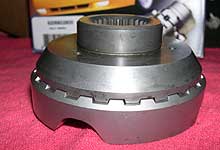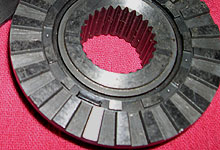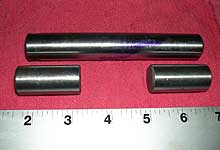|

Text by Chirag
Asaravala. Photos and Installation by Chris Monahan.
Whether it is on-road or off-road performance the age
old question is how to get maximum straight-line traction
without sacrificing the ability to turn the vehicle.
When a car goes through a turn the outside wheel must
turn at a faster rate than the inside wheel because
it will travel a greater distance through the turn.
The job then of the "differential" is to allow
the wheels to rotate at different speeds, otherwise
the inside tire would be pulled along creating excessive
tire wear and drivetrain stress.
Most automobiles come stock with an "open"
differential. An open

Open differential. |
differential splits torque evenly
between the two wheels and the amount of torque is limited
by the wheel which has the least traction. In other words,
if one wheel loses traction and starts to spin it is getting
little or no torque and thus the other wheel will also
get no torque. This is what causes the common "one
wheel peel", where one wheel is spinning and the
other is standing still.
One solution used by
auto manufacturers since the

Limited Slip Diff. clutch
pack. |
early 1960's is a limited slip
or positraction differential. This device utilizes a friction
based clutch mechanism
and stiff springs to limit the amount of slip or spin
any one wheel can incur. These units are popular because
they are quiet and offer adequate traction for low-torque
or general street use vehicles. However, as with a transmission
clutch, the friction material wears over time and loses
its effectiveness. Eventually even a limited slip or posi
differential will also result in the one wheel peel effect,
or inability to differentiate maximum torque.
Drag racers and off-roaders not concerned with turning
ability have always
had the option of using a "spool". A spool or
mini-spool is

Ford 8"/9" mini-
spool. |
a simple device
which replaces the open or traction lock differential
and locks both axles together permanently. (A full spool
replaces the differential case while a mini fits within
the case.) As a result both wheels always turn at the
same rate. This can also be achieved by welding the spider
and side gears together in an open differential. While
a spool is perfect for a dedicated drag racing vehicle,
for the majority of enthusiasts with dual purpose vehicles,
this option is just not practical.
In principle the ideal solution would be a device which
offered a true mechanical axle lock-up, like a spool,
yet functioned

Detroit Locker™ |
like an open differential while
turning. Such a solution has actually been in existence
for many decades now. Originally developed for big-torque
military and construction vehicles, the Detroit Locker™
by Tractech was adapted and marketed to performance enthusiasts.
The Locker is simply a set of toothed gears which engage
to lock both axles together when both wheels are moving
forward. When the vehicle enters a turn the faster moving
outside wheel results in disengagement of the locking
gear mechanism, allowing for differentiation. However,
the industrial design was a bit rough for street use.
The gear lash and constant engagement and disengagement
resulted in clanking and banging of the driveline and
erratic turning. Furthermore, the installation required
replacement of the stock differential case. This made
the cost of the unit quite expensive.
Eventually Powertrax®
(now a brand owned by Richmond) set out to improve upon
the long standing Locker design. Their first product,
the Powertrax Lockright, was a major improvement from
an installation and cost standpoint in that it utilized
the stock case and many of the stock components. However,
many of the original shortcomings with the ratcheting
annoyance were still apparent. We installed the Powertrax
Lockright many years ago in our Project '67 vehicle. While
the unit is still standing up to 6000 rpm launches on
slicks, it definitely is clunky through turns (see our
article "Upgrading
the Ford 8-inch Differential Powertrax Lockright Installation"
in the Rear-End section of the Tech Department.)
Some companies tried to address the locking differential
dilemma by going from automated lockup to on-demand lockup
via remote electronic switch or even pneumatic activation.
While nice in concept, in practicality installing air
compressors and tubing or wiring into a differential case
just increased cost and complexity. Richmond continued
to plug away at engineering a better automatic locking
differential. Their design criteria was to make it even
more rugged and durable, while being smoother and quieter.
Recently, they announced the new Powertrax No-Slip Traction
System. While outwardly similar to the Lockright, the
new No-Slip features a synchronizing mechanism which prevents
the ratcheting and and constant engagement-disengagement
of the teeth during turning. The end result is an automatic
locking differential which is suitable for street driven
cars.
We installed the Powertrax No-Slip into a 1966 Mustang 8"
differential. The results were remarkable to say the least.
The car previously was equipped with a mini-spool. While straight
ahead traction was ideal with the spool turning was a major
chore. We anticipated some ratcheting and bucking through turns
with the new No-Slip locking differential, however we were astonished
when the unit simply clicked twice as we entered the turn, then
again when we powered straight ahead. If we didn't know better
we'd have thought we installed it incorrectly! Follow along
with our installation process. |
 (Installation)
(Installation) |
| |
|
|
|
|
In
This Article:
Review and installation of Richmond's Powertrax
No-Slip Locking differential. |
|
| |

Shown is the Powertrax kit for
the Ford 8" rearend (PN: PX-0680-2800). Ford 9"
kits contains similar components. Installation is simple
as it utilizes the stock case and does not alter ring
and pinion settings. |
| |

The solid tooth to tooth engagement
between the coupler (top) and driver (bottom) results
in a torque capacity as much as 250% greater than the
axles themselves. The Powertrax unit not likely to be
the weak link in the drivetrain. |
| |

The inner synchronizing ring
in the coupler is unique to the Powertrax No-Slip. When
the vehicle is moving straight ahead the gaps in the
ring are aligned with the gaps in the synchro teeth.
This enables the driver and coupler to fully lock together. |
| |

The driver face consists of long
and short teeth. When the vehicle enters a turn the
synchro ring on the coupler is rotated such that the
gaps in the coupler teeth are blocked. The driver cannot
engage the coupler and thus slides along. This eliminates
the ratcheting noise common to the Lockright and other
locking differential designs. |
| |

Other features such as new specially
hardened cross shafts dramatically increase the strength
and durability of the Powertrax No-Slip. We've seen
these units behind big-block cars running in the 10's.
|
| |
| |
|
| |
|